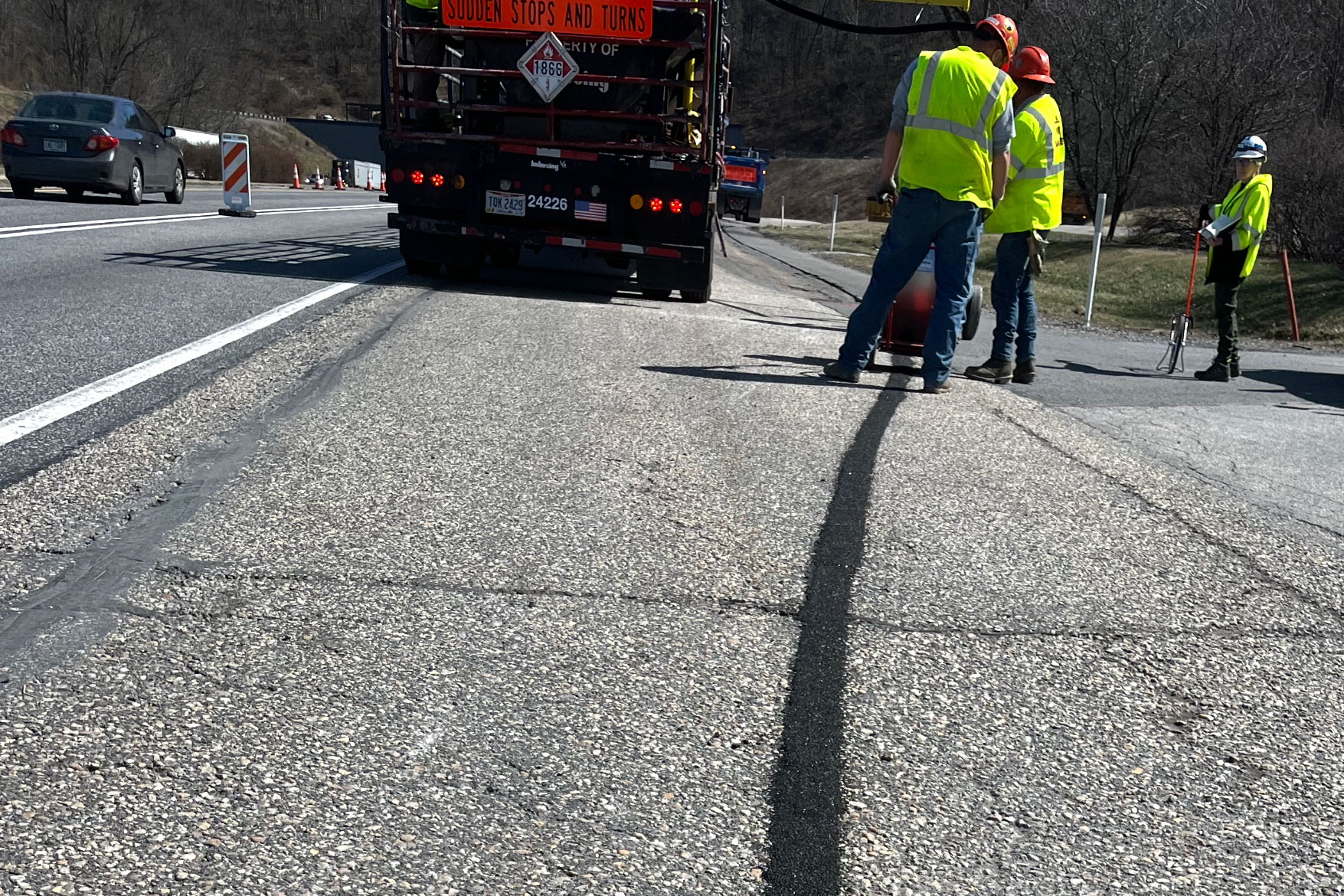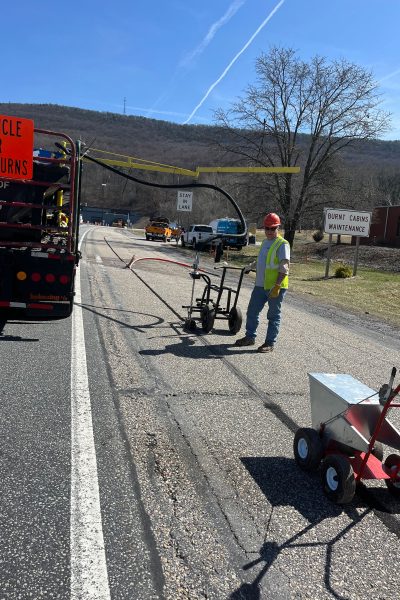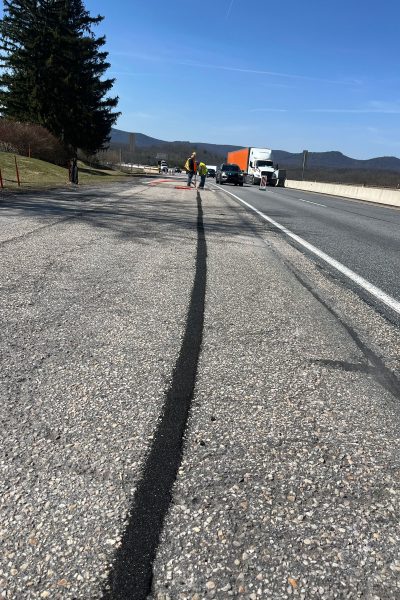Story at a glance:
- We go behind the scenes to understand the Pennsylvania Turnpike Commission’s fiber optic network installation.
- The project uses GCP’s micro-trench infill system, which will return the PA Turnpike roadways back to service faster.
The Pennsylvania Turnpike Commission (PATC) is constructing a state-of-the-art fiber optic communications network to enhance communications capabilities.
The Project
- Photo courtesy of GCP
- Photo courtesy of GCP
The new broadband network will solve two issues:
- The PATC’s Communications Capacity. Since 2003 the communications needs have increased dramatically with a 14% average annual bandwidth growth. The PATC has a challenging task of providing communications for land, mobile, radio, internet, voice, and data between its buildings, tolling points, and roadside devices. The Commission has more than 560 miles of roadway and nearly 700 sites requiring communications. The current system of utilizing leased lines and microwave towers has limited capacity due to radio spectrum availability and geographic challenges. The new fiber optic broadband network will increase connectivity between the PATC’s administrative buildings and support automated tolling capabilities, among other advanced telecommunications applications for improved safety and mobility. It will also support future needs, like connected and automated vehicles.
- The Region’s Digital Divide. The rural areas surrounding the PA Turnpike are significantly underserved with broadband infrastructure. Referred to as the “digital divide,” the PATC fiber optic network will help address this issue by extending fiber optic cable through rural areas that have been overlooked. This important initiative is a part $42.45 billion Broadband Equity, Access, and Deployment High-Speed Internet Grant Program, from which the Commonwealth of PA was earmarked $1.16 billion for future projects. A private sector partner will extend commercial fiber optic infrastructure to serve nearby businesses and residents.
In spring 2022 the PATC began the contract bidding process for contracts three and four, for the design-build installation of the fiber optic network along the PA turnpike west of Harrisburg to the Ohio border. Through the roadway portions of the PA Turnpike, the fiber will be installed in the shoulder of the PA Turnpike in micro-ducts installed by a micro-trenching process.
Today this 325-mile Western Network installation is in the midst of construction and is projected to be completed in 2026.
Challenges
The PA Turnpike was touted as “America’s First Superhighway” when it opened on October 1, 1940. It was the national standard for superhighway design and engineering.
Today the PA Turnpike stretches more than 550 miles and continues its legacy of innovation. The fiber optic communications network is a pivotal example, embracing modern-day technologies for improved safety and mobility.
But the installation of the fibers along hundreds of miles of a major highway comes with immense challenges. First and foremost is the battle against time. Pennsylvania’s seasonal weather paired with the limitations on the time of day the construction can be conducted to limit traffic interruptions, makes it extremely difficult to meet project deadlines.
There is also the challenge of the unknown. Micro-trenching along the shoulder of a historic highway uncovers unexpected obstacles like challenging ground conditions, further slowing down progress.
The Solution
Micro-trench infill systems were evaluated for the projects during the bidding process for the 325-mile Western Network fiber optic installations. After a demo conducted by GCP, SAFETRACK® MTI Road Reinstatement was selected for the mainline PA Turnpike—from the Harrisburg East Interchange to the Ohio border. SAFETRACK MTI was selected for its installation speed and proven performance in harsh, cold-weather climates like Pennsylvania.
GCP’s SAFETRACK MTI was designed specifically to infill roadways after micro-trenching is performed for underground fiber optic cable installation. It seals the trench to protect it from water ingress, supports the sides of the trench to prevent collapse, contributes to the protection of the buried cable, and provides a vehicle trafficable surface.
The GCP technical support services team worked closely with both contractors on application, operations, and strategy to maximize efficiency for both micro-trenching projects. Throughout the projects the GCP team works closely with the onsite crews to provide technical support for product and pump operations.
SAFETRACK MTI solves:
- Fluctuating Weather. The seasonal weather in Pennsylvania provides roadblocks for micro-trenching in the colder months. As SAFETRACK MTI can be applied in a wide range of temperatures and the high-performance proprietary mixture is not moisture sensitive. This opens up the opportunity to extend the construction season in both the spring and fall, keeping the project on track, and even ahead of schedule.
- Limited Construction Schedule. Most of the micro-trenching operations must be conducted during overnight closures to limit traffic disruption. SAFETRACK MTI is a cold, liquid-applied, self-consolidating micro-trench infill system that quickly takes the shape of its micro-trench. In most conditions it cures in less than 30 minutes to form a protective layer stronger than asphalt’s cohesive strength. This lasting bond protects the underground infrastructure amid freeze, thaws, and vehicle movement. The fast application and rapid curing capabilities of this technology not only expedites the project and helps reduce labor costs.
The SAFETRACK pumps and equipment enable contractors to reinstate the micro-trenches efficiently and productively. Unlike other pumps these pumps enable the implementation of aggregate. The finished SAFETRACK MTI material has a skid resistance value because of the included aggregate. Once it cures it already has skid resistance, removing that extra step. Fewer materials are used as there is no need to transport the aggregate in.
As SAFETRACK MTI is applied cold it also eliminates the added cost, permitting, and safety concerns of working with open flames, which can damage the fiber optic micro-ducts and network cables.
Results
SAFETRACK MTI is returning the PA Turnpike roadways back to service faster. From mid-October to mid-December 2023 SAFETRACK MTI was applied twice as fast as initially estimated by the applicator.
The versatility, fast application, and rapid curing capabilities of the SAFETRACK technology alleviates the project’s timeline challenges. Long-term, the high-performance materials with no critical overcoat window dramatically reduces the need for ongoing maintenance compared to traditional products. This results in lower life cycle costs associated with upkeep.
The SAFETRACK MTI even stood up to a semi-truck accident. When a semi-truck blew a tire, it veered into the shoulder where the SAFETRACK MTI had just been installed. The tire’s metal rim dug across the asphalt. When the rim hit the SAFETRACK MTI, it left no mark; it was completely undamaged. The contractors and PATC were extremely impressed with the strength of the SAFETRACK MTI.
Feedback from the contractors highlighted the GCP team’s valuable contributions to the project’s success. Their hands-on demonstrations, technical product knowledge shared during the planning stages, and ongoing assistance throughout the project were noted to be instrumental in supporting the project staff and crews.




